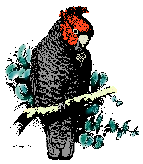I was only stating an impression that the event gave, not suggesting it was a fact, which would require a lot more observation. I'm curious why the Koels would stay around the area at all. They have Wattlebirds feeding their offspring, so there's
no need for them to be around at all. The Koels could simply head off wherever they wanted to go.
FWIW, I took video and photos of another juvenile at the ANBG on Sunday. Also being fed by Wattlebirds, although the relationship seemed dangerous. The feeding process looked more like a battle.
On Sun, 12 Jan 2025, 22:08 Philip Veerman, <> wrote:
“It was as though”. Fine, but sorry that is not convincing.
From: Rob Geraghty [
Sent: Sunday, 12 January, 2025 7:20 PM
To: shorty
Cc: Philip Veerman; CanberraBirds email list
Subject: Re: [Canberrabirds] More on the Koel
Funny to read this today. Yesterday, I think I saw a kind of interaction between an adult female Koel and a juvenile. Wattlebirds have been feeding the juvenile Koel, and it could be heard squawking for food nearby. Am adult female landed
high in a dead tree, and called loudly for some time. It was as though it was calling junior to fly north with her.
On Sun, 12 Jan 2025, 17:17 shorty via Canberrabirds, <> wrote:
"I don’t really see that there is a basis to think that is an interaction, unless there actually is a contact." I don't see why there is not.
"Sure those theories are sort of plausible but is there any basis to even raise the theories?" Any reason to not?
"Why do the adult males NOT bother the juveniles but ignore them?" Are you sure they ignore them? Evidence?
On Sun, Jan 12, 2025 at 4:54 PM Philip Veerman via Canberrabirds <> wrote:
I don’t really see that there is a basis to think that is an interaction, unless there actually is a contact. It is a proximity. The adult Koel just happens to
still be there (either because of food availability or the chance to find new breeding chances (or both) and they are making normal adult calls. Sure those theories are sort of plausible but is there any basis to even raise the theories? Is there a question
to be answered? It is fairly normal that they are just around in the same places anyway. Most years when I find juveniles, there are still adults nearby.
Actually I find the more curious question is the opposite. The alternative is that there is avoidance that might need explaining. Seeing as to us, juvenile Koels
look so similar to adult females (smaller and different head colour) and that adult male and female Koels have such vigorous interactions, why do the adult males NOT bother the juveniles but ignore them? How to they recognise the disinterest? I guess because
adult females respond to adult males (especially vocally) but juveniles do not.
Philip
From: Canberrabirds [
On Behalf Of jandaholland--- via Canberrabirds
Sent: Sunday, 12 January, 2025 3:00 PM
To: 'shorty'; 'Canberra birds'
Subject: Re: [Canberrabirds] More on the Koel
Many thanks Shorty, for your very interesting observation/
The possible reasons for Koel adult/fledgling interactions are not clear, with at least 2 theories being raised in the past, 1) to imprint the call or 2) to escort the fledglings N. Yours giving the
ko-el call (which I heard up to Christmas but not on my return) is very interesting, and perhaps lends some support for the former, since early January would seem too early for them to migrate.
My last summary (with back references) of adult/fledgling interactions is in Section 5.4 of CBN
45, 293-310 (2020) for the 2019-2020 season. I note John Harris’ adult was giving the
wirra wirra call. There were very few such observations in the bumper 2020-2021 season [Section 4.8 of CBN
46, 119-144 (2021)].
Jack Holland
From: Canberrabirds <>
On Behalf Of shorty via Canberrabirds
Sent: Sunday, 12 January 2025 12:52 PM
To: Canberra birds <>
Subject: [Canberrabirds] More on the Koel
Today I have had both the juvenile present and also an adult male calling. I took a recording where you can hear the juvenile beginning and the adult calling, they were about 20 metres apart in separate trees. Recording is on my checklist.
--
This is the email announcement and discussion list of the Canberra Ornithologists Group.
Emails posted to the list that exceed 2 MB (2,000 kB) in size, including attachments, will be rejected.
All emails distributed via the list are archived at
http://bioacoustics.cse.unsw.edu.au/archives/html/canberrabirds. It is a condition of list membership that you agree to your contributions being archived.
Canberrabirds mailing list
https://lists.canberrabirds.org.au/mailman/listinfo/canberrabirds
--
This is the email announcement and discussion list of the Canberra Ornithologists Group.
Emails posted to the list that exceed 2 MB (2,000 kB) in size, including attachments, will be rejected.
All emails distributed via the list are archived at
http://bioacoustics.cse.unsw.edu.au/archives/html/canberrabirds. It is a condition of list membership that you agree to your contributions being archived.
Canberrabirds mailing list
https://lists.canberrabirds.org.au/mailman/listinfo/canberrabirds
 ATT00001.txt
ATT00001.txt
Description: ATT00001.txt
|

